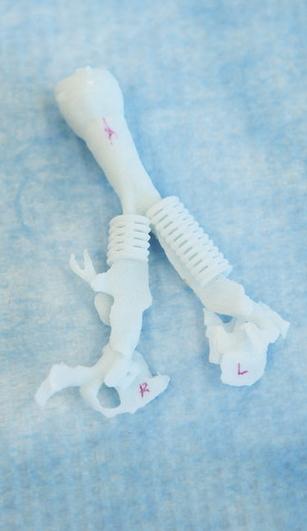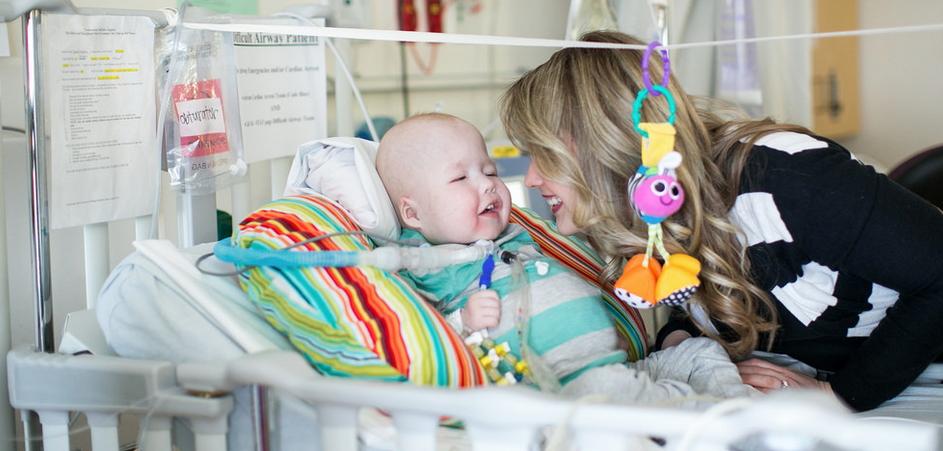Tracheobronchomalacia is a rare condition where the trachea is weak due to soft cartilage in a certain area or throughout the trachea – and sufferers have extreme difficulty breathing due to the condition.
Garrett Peterson, born in 2012, is one of those afflicted. Garrett’s windpipe would suddenly collapse leaving him gasping for breath. And it happened every day, sometimes several times.
“He’d be fine and then all of a sudden start turning blue,” says his father, Jake Peterson. “It was just like watching your child suffocate over and over again.”
The recommended treatment for the condition is surgery to correct the weakened trachea. In Garrett’s case, however, he’d been confined to intensive care since birth, and only a year ago, his team of physicians was unsure he’d live to see another.
Fate intervened when the Petersons discovered that doctors at the University of Michigan had used 3D printers to create a “splint” they used to treat the weakened windpipe condition in a child like Garrett.
Garrett had spent the first 18 months of his life hooked up to ventilators, and his condition rendered him delicate to the point that his parents were afraid to hold him. Even changing his diapers could lead to a suffocating moment.
But surgeons at the C.S. Mott Children’s Hospital at the University of Michigan implanted the 3D printed device which opened up Garrett’s airways, and as a result, Christmas is a very different experience this year at the Peterson household in Utah.
The story marks the second time a young life has been saved with this new, bioresorbable implant developed by Glenn Green, M.D., associate professor of pediatric otolaryngology, and Scott Hollister, Ph.D., professor of biomedical engineering and mechanical engineering and an associate professor of surgery.
The condition the process repaired, called tetralogy of Fallot with absent pulmonary valve, meant Garrett’s airways would collapse to the point where they became nothing more than thin slits.
 Green and Hollister had gotten emergency clearance from the Food and Drug Administration to create and implant their tracheal splint for the first patient saved by the procedure. Made from a biopolymer known as polycaprolactone, the splints are sewn around the airway to expand the bronchus and provide temporary support as a child grows. With the FDA’s approval, Garrett had his surgery scheduled for January 31, 2014.
Green and Hollister had gotten emergency clearance from the Food and Drug Administration to create and implant their tracheal splint for the first patient saved by the procedure. Made from a biopolymer known as polycaprolactone, the splints are sewn around the airway to expand the bronchus and provide temporary support as a child grows. With the FDA’s approval, Garrett had his surgery scheduled for January 31, 2014.
Over the course of about the next three years, due to the nature of the material the doctors used, the splint itself will be absorbed by Garrett’s body. The custom-fabricated device was built using high-resolution imaging and computer-aided design data collected via CT scans.
“We know the splint has been opening up the way that we wanted,” Green says. “At this point, we’re just waiting for further growth to happen and for the splint to eventually dissolve. It’s just the most rewarding thing for a physician to see somebody that had never been home from the hospital now able to enjoy the holidays.”
And Natalie Peterson can breathe again as well.
 She says she recalls a moment recently which sums up her feelings of relief. She watched as Garrett fell asleep on the floor, bathed in the glow of the lights from the family Christmas tree.
She says she recalls a moment recently which sums up her feelings of relief. She watched as Garrett fell asleep on the floor, bathed in the glow of the lights from the family Christmas tree.
“We’re just so, so excited to have him home and to be able to, you know, spend Christmas morning in our pajamas — just hanging out in our family room,” Natalie told NPR. “It’s going to be great.”
It’s a whole new world for patients who once suffered from conditions for which there was no easy solution, and 3D printing technology is extending their lives and making them more comfortable. What do you think about how 3D printing will impact medical procedures in the future? Let us know about how 3D printing is having an impact on medicine and what you see happening in the future in the 3D Printed Christmas Miracle forum thread at 3DPB.com. Check out the video describing Garrett’s condition below:
Subscribe to Our Email Newsletter
Stay up-to-date on all the latest news from the 3D printing industry and receive information and offers from third party vendors.
You May Also Like
Precision at the Microscale: UK Researchers Advance Medical Devices with BMF’s 3D Printing Tech
University of Nottingham researchers are using Boston Micro Fabrication‘s (BMF) 3D printing technology to develop medical devices that improve compatibility with human tissue. Funded by a UK grant, this project...
3D Printing Webinar and Event Roundup: April 21, 2024
It’s another busy week of webinars and events, starting with Hannover Messe in Germany and continuing with Metalcasting Congress, Chinaplas, TechBlick’s Innovation Festival, and more. Stratasys continues its advanced training...
3D Printing Webinar and Event Roundup: March 17, 2024
It’s another busy week of webinars and events, including SALMED 2024 and AM Forum in Berlin. Stratasys continues its in-person training and is offering two webinars, ASTM is holding a...
3D Printed Micro Antenna is 15% Smaller and 6X Lighter
Horizon Microtechnologies has achieved success in creating a high-frequency D-Band horn antenna through micro 3D printing. However, this achievement did not rely solely on 3D printing; it involved a combination...































